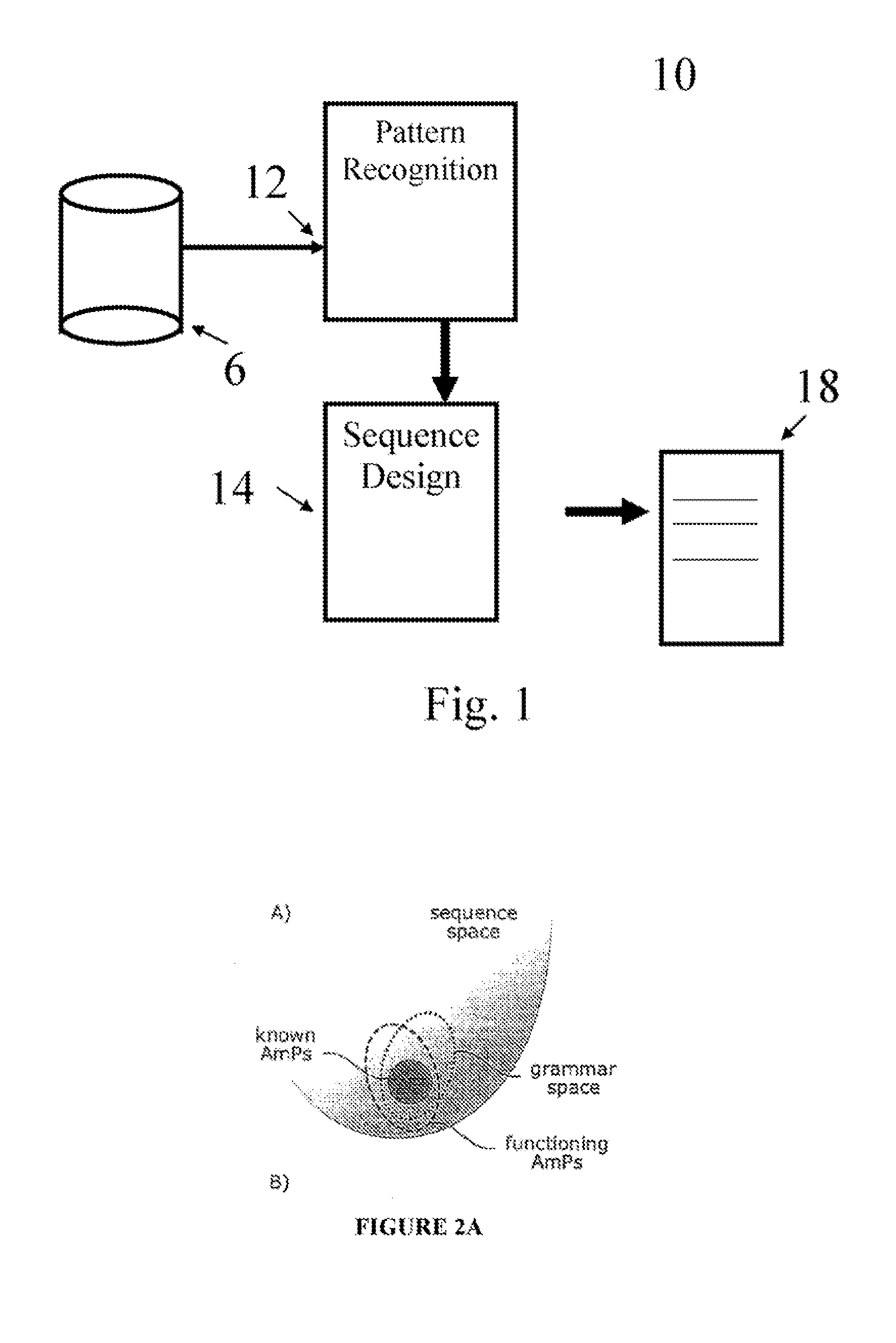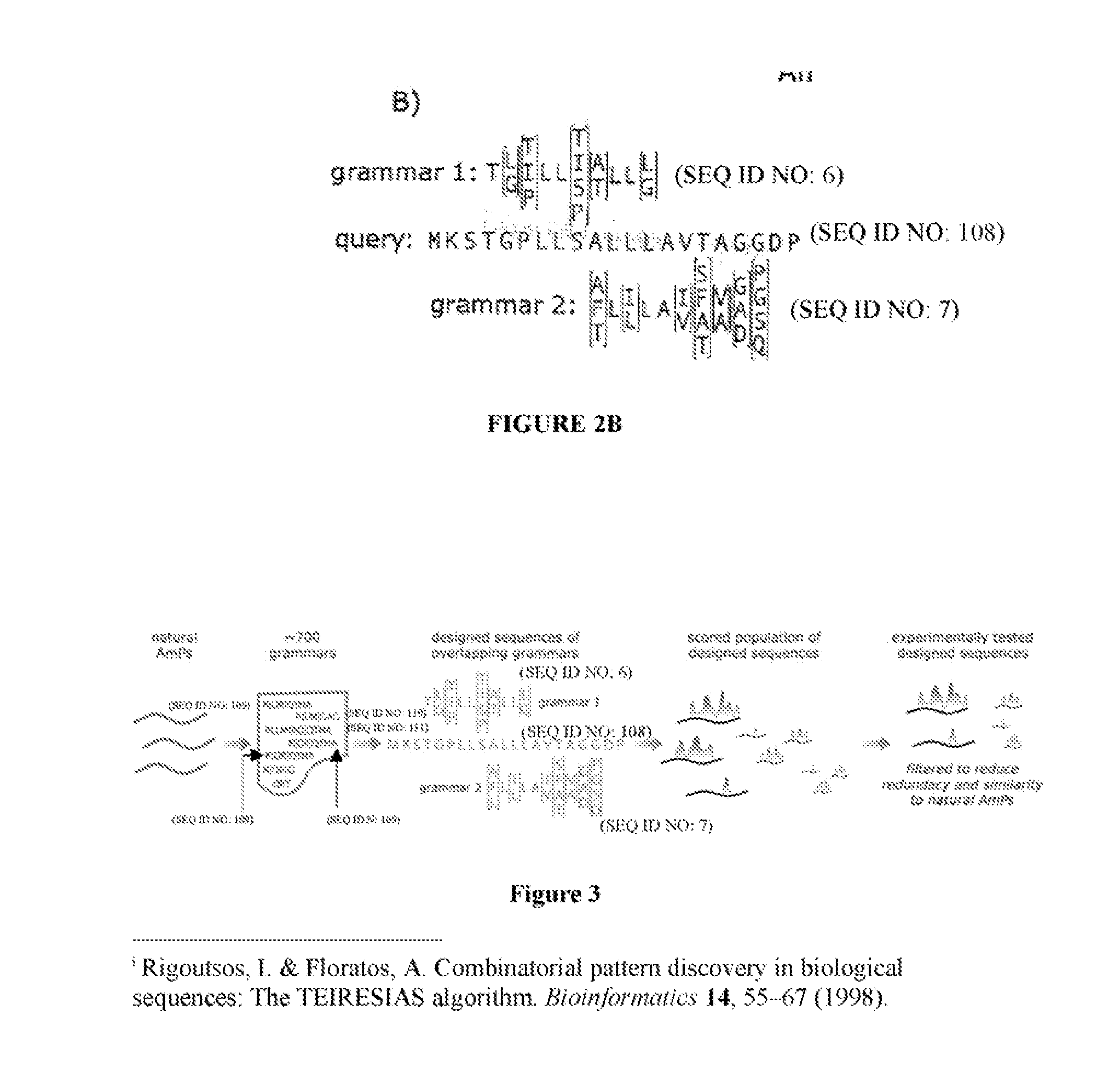Methods and Systems for Generating and Evaluating Peptides
a technology of peptides and systems, applied in the field of methods and systems for generating and evaluating peptides, can solve the problems of limited application of existing processes, difficult implementation of developed approaches for computationally determining peptide sequences of interest, and limited scope of existing processes
- Summary
- Abstract
- Description
- Claims
- Application Information
AI Technical Summary
Benefits of technology
Problems solved by technology
Method used
Image
Examples
example 1
Identification of Grammars for Antimicrobial Peptides
[0104] There is mounting evidence that antimicrobial peptides may become effective antibiotic therapies, R. E. W. Hancock, A. Patrzykat, Current Drug Targets—Infectious Disorders 2, 70 (2002). Indeed, many AmPs show activity against pathogens that are resistant to traditional antibiotics such as penicillin, tetracycline, and vancomycin, Y. Ge, et al., Antimicrob Agents Chemother 43, 782 (1999), E. Tiozzo, G. Rocco, A. Tossi, D. Romeo, Biochemical and Biophysical Research Communications 249, 202 (1998), M. B. S. m, et al., Journal of Medicinal Chemistry 46, 1567 (2003). In humans, malfunctioning AmPs can lead to severely immunocompromised phenotypes (10, 11) K. Putsep, G. Carlsson, H. G. Boman, M. Andersson, Lancet 360, 1144 (2002), H. G. Boman, Journal of Internal Medicine 254, 197 (2003). Animal models deficient in AmPs succumb to pathogen challenge, C. L. Wilson, et al., Science 286, 113 (1999), whereas transgenic mice expressi...
example 2
Design of Peptides from Grammars
[0115] One can enumerate all or substantially all possible sequences conforming to this grammar. For each grammar sequence one amino acid was chosen for each bracketed position limited to the amino acids within brackets for that corresponding position. For example, in [I / V / L]K[T / E / G / D / K]V[G / A]K[A / E / L / N / H][V / A][G / A]K (SEQ ID NO:3), one may choose one of either I, V or L for the first position and followed a similar procedure for each of the other bracketed positions. In this particular example, one chose one amino acid among each of 3 amino acids in the first position, 5 amino acids in the third position, 2 amino acids in the fifth position, 5 amino acids in the seventh position, 2 amino acids in the eighth position and 2 amino acids in the ninth position. All sequences of ten amino acids in length comprising different combinations of amino acids by multiplying out the number of possible amino acids for each bracketed position were listed, giving us 3...
example 3
Design and Synthesis of Variants of Synthetic AmPs; Drug Discovery, Using the Peptides Designed in Example 2.
[0129] Previous approaches to the design of synthetic AmPs have produced peptides that are either closely related to naturally occurring peptides, or that are composed of only a handful of amino acids, for example, poly-lysine peptides, E. Tiozzo, G. Rocco, A. Tossi, D. Romeo, Biochemical and Biophysical Research Communications 249, 202 (1998), A. Tossi, L. Sandri, A. Giangaspero, Biopolymers 55, 4 (2000). In contrast, these synthetic AmPs, by design, have an amino acid distribution similar to that of natural proteins or peptides and they populate a region of sequence space that is not occupied naturally occurring AmPs. This establishes that the linguistic approach is a means to rationally expand the natural sequence space without using structure-activity information or complex folding simulations. Instead, the process relies upon the ability of sequence grammars to capture ...
PUM
| Property | Measurement | Unit |
|---|---|---|
| concentrations | aaaaa | aaaaa |
| concentrations | aaaaa | aaaaa |
| density | aaaaa | aaaaa |
Abstract
Description
Claims
Application Information
 Login to View More
Login to View More - R&D
- Intellectual Property
- Life Sciences
- Materials
- Tech Scout
- Unparalleled Data Quality
- Higher Quality Content
- 60% Fewer Hallucinations
Browse by: Latest US Patents, China's latest patents, Technical Efficacy Thesaurus, Application Domain, Technology Topic, Popular Technical Reports.
© 2025 PatSnap. All rights reserved.Legal|Privacy policy|Modern Slavery Act Transparency Statement|Sitemap|About US| Contact US: help@patsnap.com


